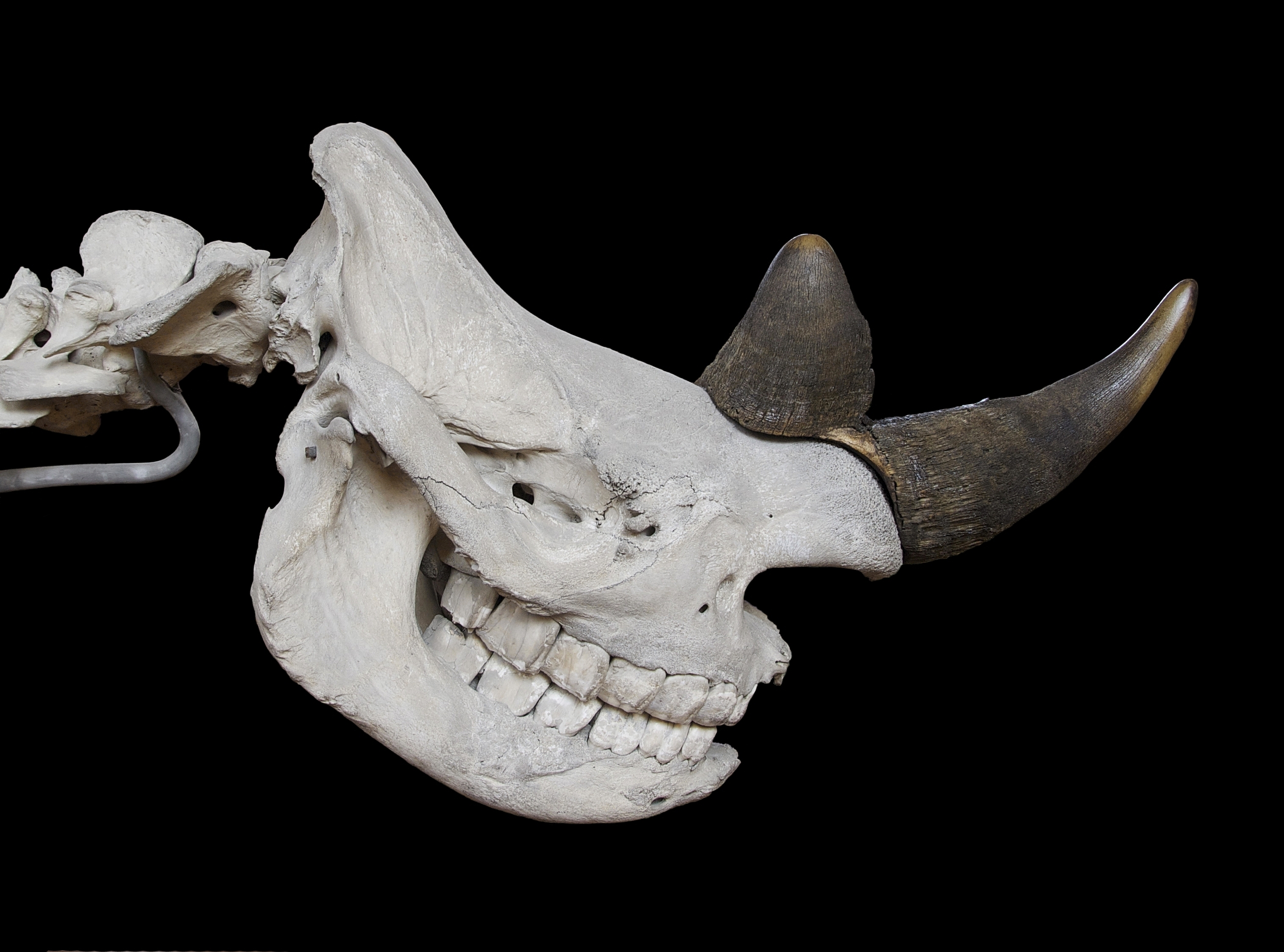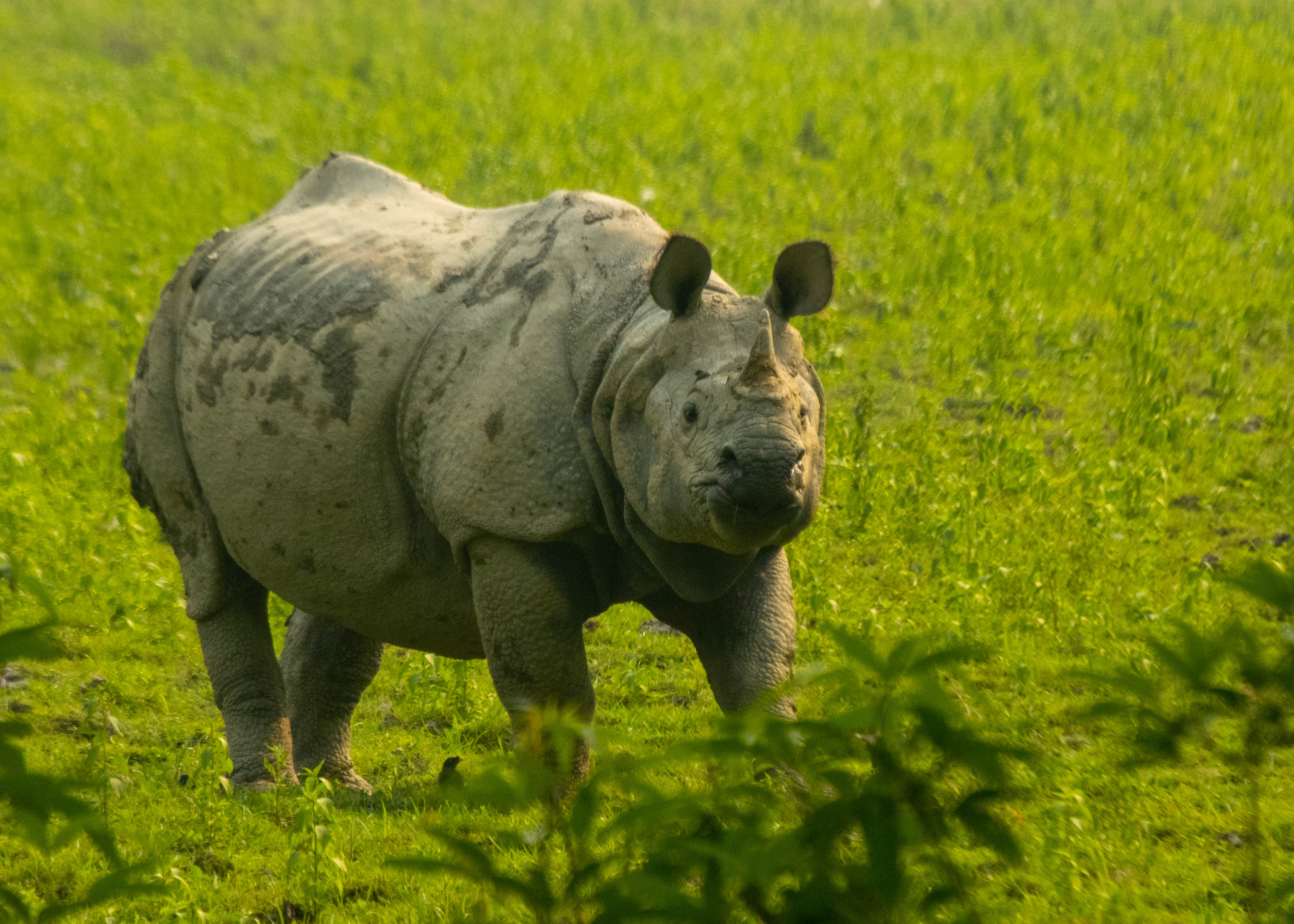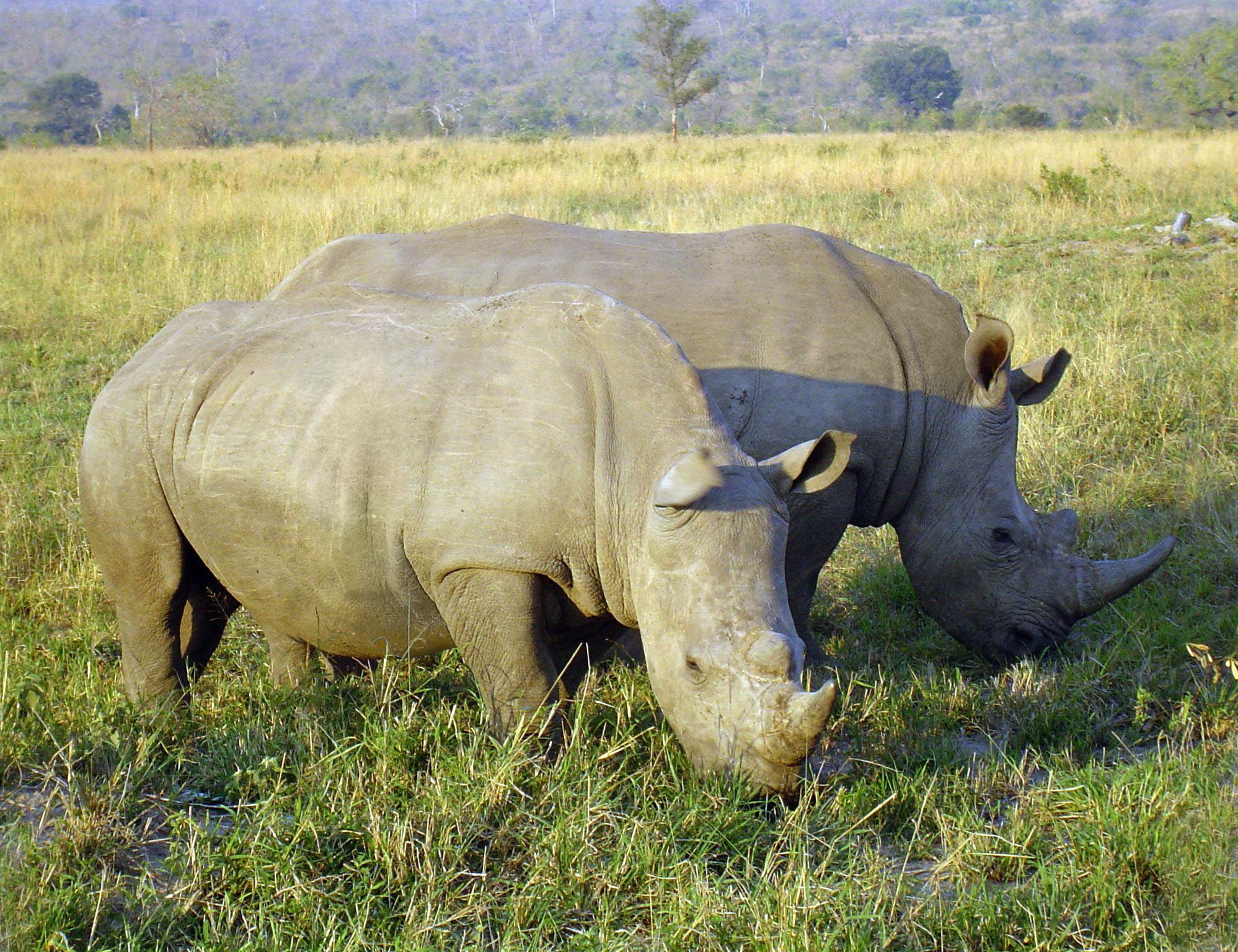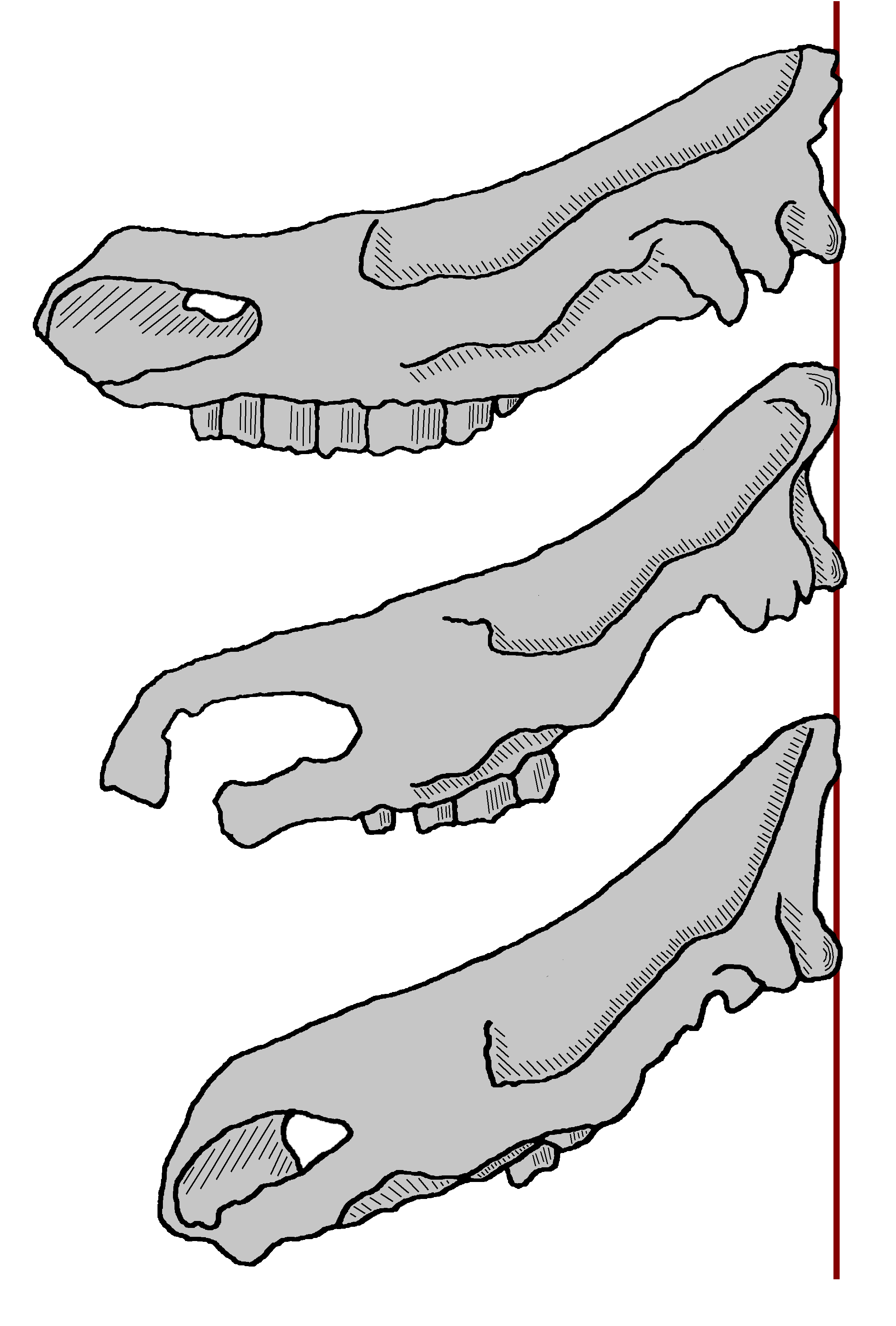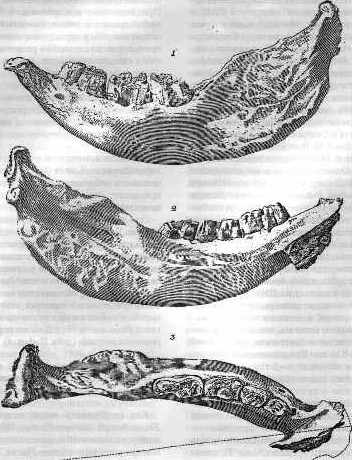|
Rhinoceros
A rhinoceros ( ; ; ; : rhinoceros or rhinoceroses), commonly abbreviated to rhino, is a member of any of the five extant taxon, extant species (or numerous extinct species) of odd-toed ungulates (perissodactyls) in the family (biology), family Rhinocerotidae; it can also refer to a member of any of the extinct species of the superfamily Rhinocerotoidea. Two of the extant species are native to Africa, and three to South Asia, South and Southeast Asia. Rhinoceroses are some of the largest remaining megafauna: all weigh over half a tonne in adulthood. They have a herbivore, herbivorous diet, small brains for mammals of their size, one or two horns, and a thick , protective skin formed from layers of collagen positioned in a crystal structure, lattice structure. They generally eat leafy material, although their ability to ferment food in their colon (anatomy), hindgut allows them to subsist on more fibrous plant matter when necessary. Unlike other perissodactyls, the two African ... [...More Info...] [...Related Items...] OR: [Wikipedia] [Google] [Baidu] |
Black Rhinoceros
The black rhinoceros (''Diceros bicornis''), also called the black rhino or the hooked-lip rhinoceros, is a species of rhinoceros native to East Africa, East and Southern Africa, including Angola, Botswana, Eswatini, Kenya, Lesotho, Malawi, Mozambique, Namibia, South Africa, Tanzania, Zambia, and Zimbabwe. Although the species is referred to as ''black'', its colours vary from brown to grey. It is the only extant species of the genus ''Diceros''. The other rhinoceros native to Africa is the white rhinoceros (''Ceratotherium simum''). The word "white" in the name "white rhinoceros" is often said to be a misinterpretation of the Afrikaans word ' (Dutch language, Dutch ') meaning wide, referring to its square upper lip, as opposed to the pointed or hooked lip of the black rhinoceros. These species are now sometimes referred to as the square-lipped (for white) or hook-lipped (for black) rhinoceros. The species overall is classified as critically endangered (even though the south-wes ... [...More Info...] [...Related Items...] OR: [Wikipedia] [Google] [Baidu] |
Sumatran Rhinoceros
The Sumatran rhinoceros (''Dicerorhinus sumatrensis''), also known as the Sumatran rhino, hairy rhinoceros or Asian two-horned rhinoceros, is a rare member of the family Rhinocerotidae and one of five extant species of rhinoceros; it is the only Extant taxon, extant species of the genus ''Dicerorhinus''. It is the smallest rhinoceros, although it is still a large mammal; it stands high at the shoulder, with a head-and-body length of and a tail of . The weight is reported to range from , averaging . Like both African species, it has two horns; the larger is the nasal horn, typically , while the other horn is typically a stub. A coat of reddish-brown hair covers most of the Sumatran rhino's body. The Sumatran rhinoceros once inhabited rainforests, swamps and cloud forests in India, Bhutan, Bangladesh, Myanmar, Laos, Thailand, Malaysia, Indonesia and southwestern China, particularly in Sichuan. It is now critically endangered, with only five substantial populations in the wild: ... [...More Info...] [...Related Items...] OR: [Wikipedia] [Google] [Baidu] |
Indian Rhinoceros
The Indian rhinoceros (''Rhinoceros unicornis''), also known as the greater one-horned rhinoceros, great Indian rhinoceros or Indian rhino, is a species of rhinoceros found in the Indian subcontinent. It is the second largest living rhinoceros species, with adult males weighing and adult females . Its thick skin is grey-brown with pinkish skin folds. It has a single horn on its snout that grows up to long. Its upper legs and shoulders are covered in wart-like bumps, and it is nearly hairless aside from the eyelashes, ear fringes and tail brush. The Indian rhinoceros is native to the Indo-Gangetic Plain and occurs in 12 protected areas in northern India and southern Nepal. It is a Grazing (behaviour), grazer, eating mainly grass, but also twigs, leaves, branches, shrubs, flowers, fruits and aquatic plants. It is a largely solitary animal, only associating in the breeding season and when rearing calves. Females give birth to a single calf after a gestation of 15.7 months. Th ... [...More Info...] [...Related Items...] OR: [Wikipedia] [Google] [Baidu] |
White Rhinoceros
The white rhinoceros, also known as the white rhino or square-lipped rhinoceros (''Ceratotherium simum''), is the largest extant species of rhinoceros and the most Sociality, social of all rhino species, characterized by its wide mouth adapted for grazing (behaviour), grazing. The species includes two subspecies with dramatically different conservation outlooks: the southern white rhinoceros, with an estimated 17,464 individuals in the wild as of the end of 2023, and the northern white rhinoceros. The northern subspecies is critically endangered and on the brink of extinction; its last known male, Sudan (rhinoceros), Sudan, died in March 2018, leaving behind only a very small number of females in captivity. Both subspecies have faced significant threats, primarily from poaching for their horns and habitat loss, which contribute to the species' overall Conservation status, conservation status of Near Threatened. Naming One popular, though widely discredited, theory for the origi ... [...More Info...] [...Related Items...] OR: [Wikipedia] [Google] [Baidu] |
Stephanorhinus
''Stephanorhinus'' is an extinct genus of two-horned rhinoceros native to Eurasia and North Africa that lived during the Late Pliocene to Late Pleistocene. Species of ''Stephanorhinus'' were the predominant and often only species of rhinoceros in much of temperate Eurasia, especially Europe, for most of the Pleistocene. The last two species of ''Stephanorhinus'' – Merck's rhinoceros (''S. kirchbergensis'') and the narrow-nosed rhinoceros (''S. hemitoechus'') – went extinct during the last glacial period. Etymology The first part of the name, ''Stephano-'', honours Stephen I, the first king of Hungary. (The genus name was coined by Kretzoi, a Hungarian.) The second part is from (Greek for "nose"), a typical suffix of rhinoceros genus names. Taxonomy The taxonomic history of ''Stephanorhinus'' is long and convoluted, as many species are known by numerous synonyms and different genera – typically ''Rhinoceros'' and '' Dicerorhinus'' – for the 19th and most of the ... [...More Info...] [...Related Items...] OR: [Wikipedia] [Google] [Baidu] |
Odd-toed Ungulate
Perissodactyla (, ), or odd-toed ungulates, is an order of ungulates. The order includes about 17 living species divided into three families: Equidae (horses, asses, and zebras), Rhinocerotidae (rhinoceroses), and Tapiridae (tapirs). They typically have reduced the weight-bearing toes to three or one of the five original toes, though tapirs retain four toes on their front feet. The nonweight-bearing toes are either present, absent, vestigial, or positioned posteriorly. By contrast, artiodactyls (even-toed ungulates) bear most of their weight equally on four or two (an even number) of the five toes: their third and fourth toes. Another difference between the two is that perissodactyls digest plant cellulose in their intestines, rather than in one or more stomach chambers as artiodactyls, with the exception of Suina, do. The order was considerably more diverse in the past, with notable extinct groups including the brontotheres, palaeotheres, chalicotheres, and the paracer ... [...More Info...] [...Related Items...] OR: [Wikipedia] [Google] [Baidu] |
Perissodactyl
Perissodactyla (, ), or odd-toed ungulates, is an order of Ungulate, ungulates. The order includes about 17 living species divided into three Family (biology), families: Equidae (wild horse, horses, Asinus, asses, and zebras), Rhinocerotidae (rhinoceroses), and Tapiridae (tapirs). They typically have reduced the weight-bearing toes to three or one of the five original toes, though tapirs retain four toes on their front feet. The nonweight-bearing toes are either present, absent, Vestigiality, vestigial, or positioned posteriorly. By contrast, Artiodactyl, artiodactyls (even-toed ungulates) bear most of their weight equally on four or two (an even number) of the five toes: their third and fourth toes. Another difference between the two is that perissodactyls digest plant cellulose in their intestines, rather than in one or more stomach chambers as artiodactyls, with the exception of Suina, do. The order was considerably more diverse in the past, with notable extinct groups inclu ... [...More Info...] [...Related Items...] OR: [Wikipedia] [Google] [Baidu] |
Rhinoceros (genus)
''Rhinoceros'' is a genus comprising one-horned rhinoceroses. This scientific name was proposed by Swedish taxonomist Carl Linnaeus in 1758. The genus contains two species, the Indian rhinoceros (''Rhinoceros unicornis'') and the Javan rhinoceros (''Rhinoceros sondaicus''). Although both members are threatened, the Javan rhinoceros is one of the most endangered large mammals in the world with only 60 individuals surviving in Java (Indonesia). The word 'rhinoceros' means "nose-horn" in Ancient Greek. Etymology The genus name ''Rhinoceros'' comes from the Ancient Greek words ῥινο- (''rhino-''), meaning "of the nose" and κέρας (''kerás''), meaning "horn". Classification The genus ''Rhinoceros'' comprises: *Indian rhinoceros (''R. unicornis'') Indian subcontinent * Javan rhinoceros (''R. sondaicus'') Southeast Asia *†'' R. sivalensis'' Falconer and Cautley, 1846 northern Indian subcontinent ( Siwalik Hills) Pliocene-Early Pleistocene *†'' R. platyrhinus'' Falcon ... [...More Info...] [...Related Items...] OR: [Wikipedia] [Google] [Baidu] |
Coelodonta
''Coelodonta'' (, from the Ancient Greek κοῖλος (''koîlos''), meaning "hollow", and οδούς (''odoús''), meaning "tooth", in reference to the deep grooves of their molar (tooth), molars) is an extinct genus of Eurasian rhinoceroses that lived from about 3.7 million years to 14,000 years ago, in the Pliocene and the Pleistocene epochs. It is best known from the type species, the woolly rhinoceros (''Coelodonta antiquitatis''), which ranged throughout northern Eurasia during the Pleistocene. The earliest known species, ''Coelodonta thibetana,'' lived in Tibet during the Pliocene, with the genus spreading to the rest of Eurasia during the Pleistocene. ''Coelodonta'' presumably grew to be around 3.6m long and 1.7m tall. Species Species recognised as members of ''Coelodonta'', according to Deng ''et al''. (2011), include: * ''Coelodonta thibetana'' (Deng et al. 2011): The most primitive species of the genus, inhabited the Tibetan Plateau during the Pliocene. * ''Coelodo ... [...More Info...] [...Related Items...] OR: [Wikipedia] [Google] [Baidu] |
Dicerorhinus
''Dicerorhinus'' (Greek: "two" (dio), "horn" (keratos), "nose" (rhinos)) is a genus of the family Rhinocerotidae, consisting of a single extant species, the two-horned Sumatran rhinoceros (''D. sumatrensis''), and several extinct species. The genus likely originated from the Late Miocene of central Myanmar. Many species previously placed in this genus probably belong elsewhere''.'' Taxonomy Species provisionally considered valid include: * †''Dicerorhinus fusuiensis'' originally described as ''Rhinoceros'' ''fusuiensis'' Early Pleistocene, South China. * †''Dicerorhinus gwebinensis'' Zin-Maung-Maung-Thein et al., 2008 Known from a skull of Pliocene-Early Pleistocene age found in Myanmar. Some authors have considered the skull not distinguishable from that of ''D. sumatrensis''. Historically, ''Dicerorhinus'' was a wastebasket taxon. Revisions by several authors over the years have removed many species: Transferred to ''Stephanorhinus ''Stephanorhinus'' is an extinct genu ... [...More Info...] [...Related Items...] OR: [Wikipedia] [Google] [Baidu] |
Elasmotherium
''Elasmotherium'' is an extinct genus of large rhinoceros that lived in Eastern Europe, Central Asia and East Asia during Late Miocene through to the Late Pleistocene, with the youngest reliable dates of at least 39,000 years ago. It was the last surviving member of Elasmotheriinae, a distinctive group of rhinoceroses separate from the group that contains living rhinoceros (Rhinocerotinae). Five species are recognised. The genus first appeared in the Late Miocene in present-day China, likely having evolved from '' Sinotherium'', before spreading to the Pontic–Caspian steppe, the Caucasus and Central Asia. The best known ''Elasmotherium'' species, ''E. sibiricum'', sometimes called the Siberian unicorn, was among the largest known rhinoceroses, with an estimated body mass of around , comparable to an elephant, and is often conjectured to have borne a single very large horn. However, no horn has ever been found, and other authors have conjectured that the horn was likely ... [...More Info...] [...Related Items...] OR: [Wikipedia] [Google] [Baidu] |
Ceratotherium
''Ceratotherium'' (from Greek: ''keras'' κέρας "horn" and ''thērion'' θηρίον "beast") is a genus within the family Rhinocerotidae. It comprises one living species, the white rhinoceros (''Ceratotherium simum''), and several extinct fossil species that trace its evolutionary lineage. Taxonomy and evolution The genus ''Ceratotherium'' belongs to the tribe Dicerotini (also spelled Diceroti) or subtribe Dicerotina, indicating a closer evolutionary relationship to the genus '' Diceros'' (which includes the black rhinoceros) than to other extant rhinoceros genera. The evolutionary history of ''Ceratotherium'' includes several recognized and debated fossil species: * '' Ceratotherium mauritanicum'': An extinct species known from the Pleistocene of North Africa. Some Pliocene East African remains, alternatively attributed by some authors to ''Ceratotherium efficax'', are sometimes included in ''C. mauritanicum''. Depending on the inclusion of these East African materials, ' ... [...More Info...] [...Related Items...] OR: [Wikipedia] [Google] [Baidu] |

